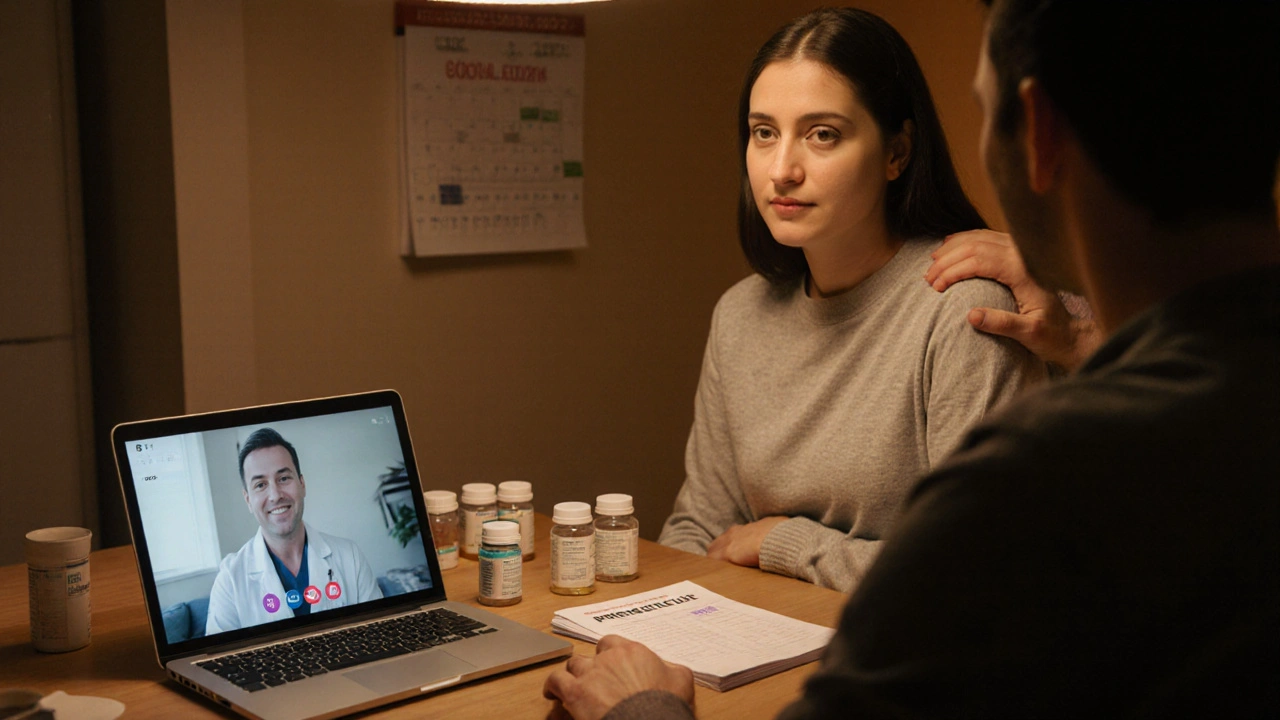When a woman with multiple sclerosis starts thinking about starting a family, a mix of excitement and uncertainty often follows. The good news is that most people with MS go on to have healthy pregnancies and babies, but the journey does need some extra planning. Below you’ll find a step‑by‑step guide that covers the medical, emotional, and practical angles, so you can feel confident about the road ahead.
Quick Takeaways
- Pregnancy generally lowers the annual relapse rate by about 30%.
- Most disease‑modifying therapies (DMTs) are stopped before conception; exceptions are limited.
- Close coordination between your neurologist and obstetrician is essential.
- Vitamin D, balanced diet, and moderate exercise help keep symptoms in check.
- Post‑partum relapse risk rises, so a clear medication plan is vital.
Understanding MS and Pregnancy
MS is an autoimmune condition where the immune system attacks the protective sheath (myelin) around nerves. This leads to symptoms like fatigue, numbness, and occasional muscle weakness. Hormonal shifts during pregnancy-especially the rise in estrogen and progesterone-tend to dampen the immune response, which is why many women report fewer relapses while they’re pregnant.
However, each pregnancy is unique. Some women experience the same symptom pattern, while others notice a temporary flare‑up after the first trimester. Knowing what’s typical helps you spot anything that truly needs medical attention.
Pre‑Conception Planning
Before you start trying, schedule a joint appointment with your obstetrician and neurologist. Bring a full medication list, recent MRI results, and any past relapse records. The key goals of this meeting are:
- Identify which disease‑modifying therapy (DMT) you’re on and whether it’s safe to continue.
- Discuss timing for tapering or switching medications.
- Review vaccination status-especially flu and COVID‑19 boosters.
- Set up a baseline for monitoring fatigue, mobility, and bladder function.
Most oral DMTs (e.g., fingolimod, dimethyl fumarate) and infused therapies (e.g., natalizumab, ocrelizumab) are advised to stop at least three months before conception due to limited safety data. Interferon‑beta and glatiramer acetate have the most reassuring pregnancy records and may be continued in some cases, but only under specialist guidance.
Medication Adjustments: What to Keep, What to Stop
Below is a quick reference for the most common DMTs and their typical pregnancy recommendations.
| Medication | Pregnancy Category | Typical Action |
|---|---|---|
| Interferon‑beta | Low‑risk (Category B) | May be continued with specialist approval |
| Glatiramer acetate | Low‑risk (Category B) | Often continued; safe in many registries |
| Fingolimod | Contra‑indicated (Category X) | Stop ≥3 months before conception |
| Natalizumab | Limited data (Category C) | Switch to safer alternative before pregnancy |
| Ocrelizumab | Limited data (Category C) | Discontinue ≥6 months prior |
Always discuss the plan with both specialists. Stopping a DMT abruptly can sometimes trigger a rebound effect, so a tapering schedule may be required.
Monitoring Relapses During Pregnancy
A relapse is defined as new or worsening neurological symptoms lasting more than 24hours, not caused by fever or infection. While the overall relapse rate drops, roughly 10‑15% of pregnant women with MS still experience a flare, most often in the first trimester.
If a relapse occurs, high‑dose corticosteroids (e.g., methylprednisolone) are the first line of treatment. The medication crosses the placenta minimally, especially after the first trimester, and is considered relatively safe. Intravenous immunoglobulin (IVIG) is an alternative for those who cannot take steroids.
Schedule MRI scans only when absolutely necessary. A MRI without gadolinium contrast is generally regarded as safe throughout pregnancy because the magnetic fields do not harm the fetus.

Optimising Prenatal Care
Beyond medication, a few lifestyle tweaks can make a big difference:
- Vitamin D: Aim for 1000‑2000IU daily, unless your blood test suggests otherwise. Low vitamin D is linked to higher relapse risk.
- Balanced diet rich in omega‑3 fatty acids (salmon, walnuts) supports nerve health.
- Gentle exercise-swimming, prenatal yoga, or walking-helps maintain mobility and reduces fatigue.
- Stay hydrated and use the bathroom regularly to avoid urinary tract infections, which can trigger relapses.
Consider a birth plan that includes a neurologist on call, especially if you’re on a medication that may need rapid adjustment during labor.
Labor, Delivery, and the Immediate Post‑Partum Period
Most women with MS deliver vaginally without complications, but some opt for a planned C‑section if they have severe mobility issues or bladder dysfunction that could interfere with pushing.
During labor, avoid prolonged dehydration and maintain comfortable positioning to minimize fatigue. After the baby arrives, the relapse risk climbs back up, peaking around six weeks postpartum.
Discuss with your neurologist whether you’ll restart a DMT immediately after delivery. If you plan to breastfeed, note that only interferon‑beta and glatiramer acetate have sufficient safety data for use while nursing. Other DMTs are usually paused until breastfeeding ends.
Breastfeeding and MS
Breastfeeding offers many benefits for both mother and child, and several studies suggest it may further lower the short‑term relapse rate. However, the decision should balance the infant’s nutritional needs with your medication requirements.
If you’re able to use a compatible DMT, exclusive breastfeeding for the first two months is often feasible. Otherwise, expressed breast milk can be continued while you resume treatment, though you should discuss any potential drug exposure with a pediatrician.
Creating a Personal Preparation Checklist
- Set up a pre‑conception meeting with neurologist and obstetrician.
- Review and adjust DMT regimen according to safety guidelines.
- Update vaccinations (flu, COVID‑19, Tdap).
- Arrange baseline blood work: vitamin D, iron, thyroid panel.
- Plan a prenatal exercise routine that feels sustainable.
- Identify a support network-partner, family, MS support groups.
- Draft a birth plan that notes MS-specific concerns (e.g., mobility assistance, IV access).
- Discuss postpartum medication strategy and breastfeeding preferences.
- Schedule a postpartum follow‑up with your neurologist within six weeks of delivery.
Having this checklist in hand reduces anxiety and ensures you don’t miss any critical step.
Resources and Support Channels
Connecting with other moms who have MS can be a game‑changer. Here are a few reliable venues:
- MS Society Pregnancy Hub: Offers webinars, printable guides, and a forum for Q&A.
- Local NHS MS clinics often host monthly “Moms‑to‑Moms” meet‑ups.
- Online patient registries (e.g., MS Pregnancy Registry) provide up‑to‑date safety data on newer therapies.
- Professional counselling-both medical and mental health-helps manage stress, which itself can affect relapse rates.

Frequently Asked Questions
Will MS affect my fertility?
MS itself does not reduce fertility. However, some DMTs (like interferon‑beta) have theoretical concerns, so your neurologist may advise a short wash‑out period before trying to conceive.
Is it safe to have a C‑section if I have MS?
A C‑section is safe for women with MS, but it’s usually reserved for obstetric indications or severe mobility issues. Vaginal delivery remains the preferred route for most.
Can I travel during pregnancy if I have MS?
Yes, as long as you stay hydrated, move around every 1‑2hours, and have a plan for locating nearby medical facilities. Carry a copy of your medication list and a note from your neurologist.
What should I do if I experience a relapse in the third trimester?
High‑dose corticosteroids are still an option and are considered safe after the first trimester. Discuss any concerns with both your neurologist and obstetrician promptly.
How long after delivery can I restart my DMT?
If you’re not breastfeeding, many neurologists restart treatment within 2‑4weeks to reduce relapse risk. If you are breastfeeding, you may wait longer or choose a DMT compatible with nursing.

Namrata Thakur
September 28, 2025 AT 11:33First of all, congratulations on taking the step to learn about pregnancy with MS. Understanding how hormones can quiet the immune system helps set a positive tone for the months ahead.
Make sure you schedule that joint appointment with both your neurologist and obstetrician; having both perspectives in the same room saves a lot of back‑and‑forth.
Bring a full medication list, recent MRI scans, and a quick diary of any relapses you’ve had; that paper trail lets the doctors tailor a safe tapering plan.
When it comes to disease‑modifying therapies, the safest bets during pregnancy are interferon‑beta and glatiramer acetate, but only under specialist supervision.
If you’re on fingolimod, natalizumab, or ocrelizumab, you’ll need to stop them well before you try to conceive – the guidelines usually say three to six months.
Don’t panic if you hear the word “stop”; a carefully timed taper can prevent rebound activity, and many women stay relapse‑free throughout pregnancy.
Vitamin D plays a surprisingly big role; aim for 1,000‑2,000 IU daily unless your blood work says otherwise.
Omega‑3 rich foods like salmon and walnuts can support nerve health and may also help keep fatigue at bay.
Gentle exercise such as prenatal yoga or swimming keeps mobility up and mood stable – just avoid over‑exertion.
Stay hydrated, especially in the third trimester, because dehydration can mimic MS fatigue.
Watch for urinary tract infections early; a simple infection can trigger a flare, so prompt treatment is key.
When you go into labor, keep a comfortable position and have a plan for IV access if a relapse occurs – many hospitals can have a neurologist on call.
After delivery, the relapse risk rises, so discuss a postpartum DMT restart timeline with your team now, not later.
If you plan to breastfeed, know that interferon‑beta and glatiramer acetate have the most data for safety while nursing.
Other DMTs usually need to wait until you finish breastfeeding, but an individualized plan can balance infant nutrition with your health needs.
Finally, build a support network – partner, family, or an online MS pregnancy forum – because emotional support is just as vital as the medical plan.
Aman Vaid
October 2, 2025 AT 03:05Ensure that any medication changes are documented in a written plan signed by both neurologist and obstetrician; this reduces ambiguity during emergencies.
KayLee Voir
October 5, 2025 AT 18:37Reading through the guide, I was struck by how vital vitamin D and a steady exercise routine are for managing MS symptoms during pregnancy; both are low‑effort interventions that pay big dividends.
Keeping a simple symptom diary can also help your doctors spot subtle changes early.
Bailey Granstrom
October 9, 2025 AT 10:09Skipping the DMT without a taper is a recipe for a rebound flare.
Melissa Corley
October 13, 2025 AT 01:40Honestly, the “stop all meds” hype scares everyone, but most modern DMTs have clear guidelines – 🙄.
Kayla Rayburn
October 16, 2025 AT 17:12It’s a great idea to draft a birth plan that lists MS‑specific needs like mobility assistance and IV access; hospitals appreciate the clarity and you’ll feel less anxious.
Dina Mohamed
October 20, 2025 AT 08:44Great point about hydration!
Remember to sip water every hour, especially during labor, to keep fatigue at bay!!!
Kitty Lorentz
October 24, 2025 AT 00:16the postpartum check in with your neurologist is crucial don't forget it
inas raman
October 27, 2025 AT 14:47Yo, building a buddy system with other MS moms can really lift your spirits – get a group chat going.
Jenny Newell
October 31, 2025 AT 06:19From a pathophysiological standpoint, the shift toward Th2 cytokine dominance in gestation modulates autoreactive T‑cell activity, thereby reducing relapse propensity.
Kevin Zac
November 3, 2025 AT 21:51Namrata’s checklist hits every major box – I’d add a quick mental health screen before conception; anxiety can subtly influence relapse risk.
Stephanie Pineda
November 7, 2025 AT 13:23Melissa’s emoji‑laden warning feels a bit melodramatic; the data actually support a measured approach to DMT discontinuation.
Anne Snyder
November 11, 2025 AT 04:54While the science is reassuring, many patients still feel uneasy, so a shared decision‑making session that addresses emotional concerns can bridge that gap.
Rebecca M
November 14, 2025 AT 20:26All clinicians should ensure that medication lists are up‑to‑date, that lab results are reviewed, and that consent forms are signed; any deviation may jeopardize patient safety.
Andrew Irwin
November 18, 2025 AT 11:58I think it’s helpful to keep a simple calendar for appointments so nothing slips through the cracks.
Joseph Kloss
November 22, 2025 AT 03:30Data shows relapse rates drop by roughly 30 % during pregnancy – numbers don’t lie.
Anna Cappelletti
November 25, 2025 AT 19:01I’m curious how the timing of DMT re‑initiation postpartum affects long‑term disability progression; does anyone have recent cohort data?
Dylan Mitchell
November 29, 2025 AT 10:33The journey of pregnancy with MS is a marathon of resilience, a fire that refuses to be extinguished!